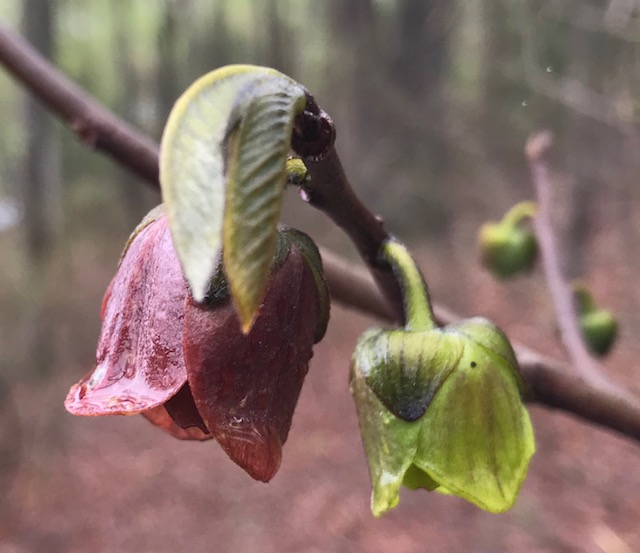
Another road warrior! This magical flower was felled from the top of a very tall tulip tree by a hungry caterpillar.

Another road warrior! This magical flower was felled from the top of a very tall tulip tree by a hungry caterpillar.

Leaf me alone! Just try walking in the woods this time of year! Leaves are overwhelming. The world is so green! Oak and tulip in photo.

The sun continues its northward journey, wishing us a peaceful good night as it peeks through a lacy white mulberry finally in flower!

Who thinks of dried seed heads falling and covering the ground in the spring? The red maple tree provides its own version of autumn leaves but wearing unique pink colors that could only be found in the spring.

Depending on the interest of our local bird population I hope to be able to follow the development of these tiny wild cherries and show you how they grow. They are very edible. Once upon a time I was famous for my wild cherry jelly.

Look what I found behind an old barn at the back of a field! So overwhelmed by the beauty of such incredible masses of cherry blossoms I forgot to take a photo of the snowfall of white petals swirling around me and blanketing the ground. You’ll just have to imagine!

Pawpaw blossoms are among my favorite spring flowers. The pawpaw fruit is delicious but squirrels and deer usually get to it before I do. Do you know the nursery rhyme song, “Pickin’ up Pawpaws! Put ’em in your pocket?”
Call it the American Custard Apple or the West Virginia Banana, but it’s neither apple nor banana. It’s the Paw-paw (Asimina trilob), the largest native fruit of North America, and it grows throughout Appalachia. There are about seven other members of the genus Asimina, all growing in the southeastern U.S. Mature pawpaw trees produce fruits 2″ wide by 10″ long, which turn from green, to yellow, and then black as they ripen in the fall.
Where, oh where is pretty little Susie?
Where, oh where is pretty little Susie?
Where, oh where is pretty little Susie?
Way down yonder in the paw-paw patch.Come on, boys [or girls, or kids], let’s go find her,
Come on, boys, let’s go find her,
Come on, boys, let’s go find her,
Way down yonder in the paw-paw patch.Pickin’ up paw-paws, puttin’ ‘em in her pockets,
Pickin’ up paw-paws, puttin’ ‘em in her pockets,
Pickin’ up paw-paws, puttin’ ‘em in her pockets,
Way down yonder in the paw-paw patch.—The Paw Paw Patch
Traditional folk song
Paw-paw fruits are rich in minerals such as magnesium, copper, zinc, iron, manganese, potassium, and phosphorus. The fruit also contains abundant concentrations of Vitamin C, proteins, and their derivative amino acids. The Peterson Field Guide mentions that the seeds, along with being an emetic, have narcotic properties.
 The paw-paw pulp may be eaten raw, made into ice cream, baked, or used as a pie filling. Some Appalachian cooks make a custard out of “Poppaws.” Seed them, mash them, add milk, a little sugar, an egg and some allspice. Pour the batter into custard cups and set those in a bread pan with some water in the bottom of the pan. Bake at a medium heat. Stick a broom straw or toothpick in, and when it comes up clean it’s done. Paw-paw also makes an excellent dry, white wine. It can be made from fresh or canned fruit.
The paw-paw pulp may be eaten raw, made into ice cream, baked, or used as a pie filling. Some Appalachian cooks make a custard out of “Poppaws.” Seed them, mash them, add milk, a little sugar, an egg and some allspice. Pour the batter into custard cups and set those in a bread pan with some water in the bottom of the pan. Bake at a medium heat. Stick a broom straw or toothpick in, and when it comes up clean it’s done. Paw-paw also makes an excellent dry, white wine. It can be made from fresh or canned fruit.
The paw-paw is sensitive to ultraviolet light, thus, paw paw seedlings may not grow back after forests have been clear cut, and there are very few virgin forests left in the United States. Paw-paws can be found growing there abundantly, but once the forests are harvested, the paw paw will not usually re-establish.
sources: www.fred.net/kathy/pawpaws.html
http://www.pawpaw.kysu.edu/

Crazy daffodils plus crazy maple seeds make a crazy arrangement! A new way to mix and match and find your happy place! Everybody gets so excited about cherry blossoms. Maples are blooming at the same time!

Hardly looks like it’s weeping! This cherry is obviously sobbing!